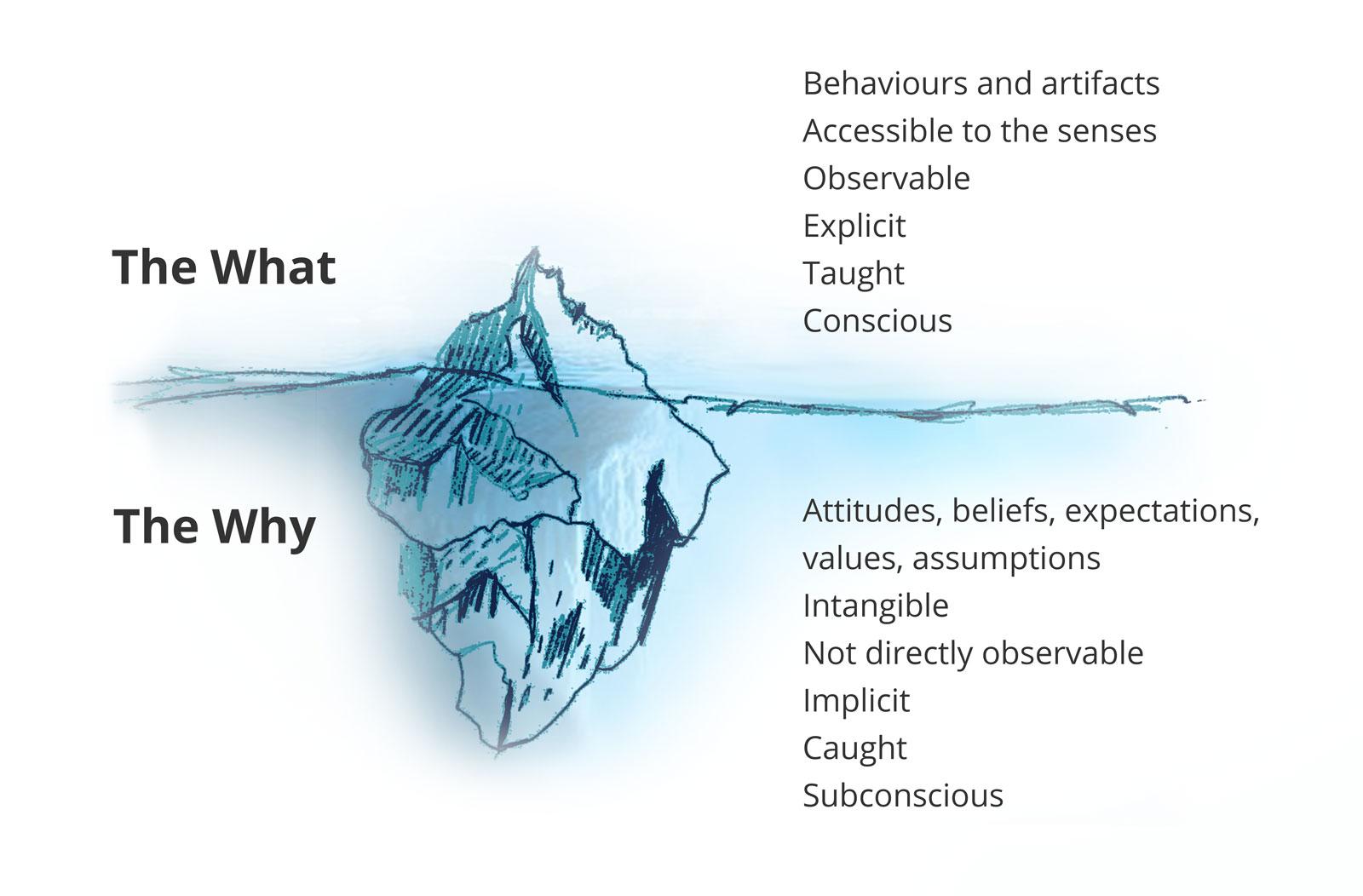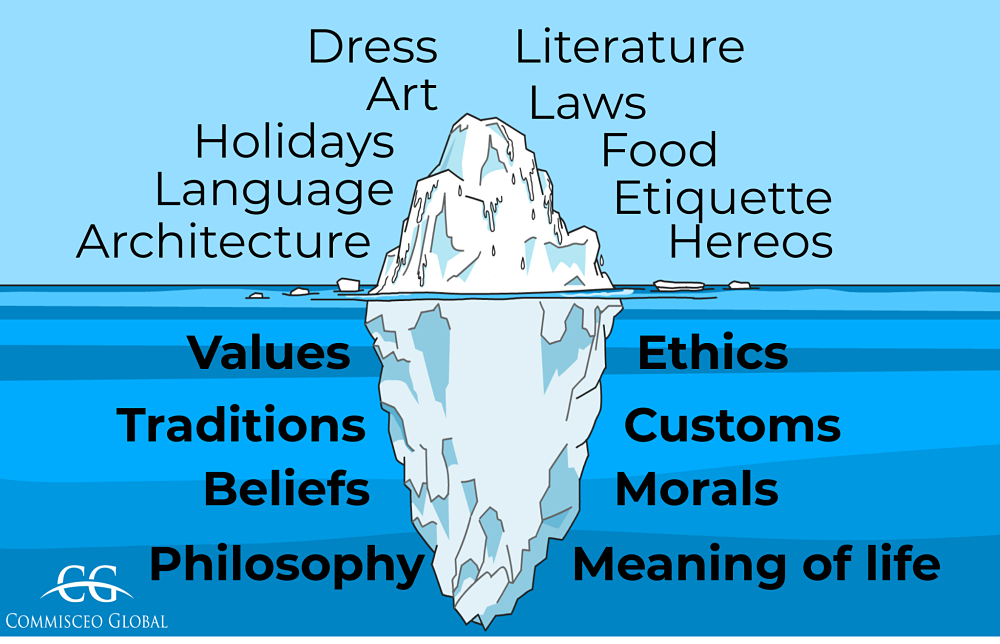The Culture Iceberg Analogy Is Used to Describe What
Aspects of culture that are explicit visible taught. Furthermore why is the culture of a society compared to an.

The Cultural Iceberg Communication Emi
The iceberg is a wonderful analogy to understand childrens behaviour and the reasons behind the behaviour.

. In what is known as the iceberg model of understanding culture you can observe about 10 of culture but to comprehend the rest you have to go deeper. The Iceberg Theory The Iceberg Theory suggests that just like an iceberg culture is made of a visible and an invisible part Edward T. Part of it emerges and submerges with the tides and its foundations go deep beneath the surface.
An Analogy of Culture. We often use the analogy of an iceberg when we talk about culture. Within intercultural training though there is one model or analogy of culture that most agree sums up the concept best.
The cultural iceberg is a helpful analogy to explore explicit and implicit aspects of culture. And that is the iceberg. Hidden differences include cultural values and assumptions.
It exists just below the level of consciousness before the unconscious mind. In the iceberg model of multicultural influences on communication the iceberg analogy is used because much of what affects communication a. Most aspects of a culture are hard to see.
The proverbial tip of the iceberg symbolizes the observable behaviors in a culture as well as the things you can see hear and touch such as dress language food music architecture signs of affection etc. Values are the worth we attach to. Culture cultural iceberg implicit explicit deep surface Hall Edward united church beliefs values traditions attitudes assumptions conscious Created Date.
Conscious Preconscious and Unconscious behavior. Like an iceberg the bulk of behaviours mass is hidden below the surface. We often use the analogy of an iceberg when we talk about culture.
The iceberg analogy of change proposes that _____. Furthermore the fate of the Titanic. Recounting tribal heroic myths Deal.
The iceberg analogy. Can be determined by looking very closely for clues. Observation that in many if not most cases only a very small amount the.
The Iceberg metaphor for culture shows a cruise ship sailing close to the iceberg for a look at this foreign territory. How is an onion a metaphor for culture. The iceberg metaphors of culture states that we can only see or point out the surface elements of cultures.
The inner core equates to the submerged base of the iceberg. Intervention strategies should address both visible and hidden aspects of an organization. New immigrants to a culture will often realize this fast.
The popular iceberg metaphor illustrates hidden culture. Asked Apr 22 2016 in Business by SanFran78. Hidden Product Cost Illustration.
The proverbial tip of the iceberg symbolizes the observable behaviors in a culture as well as the things you can see hear and touch such as dress language food music architecture signs of affection etc. Hall - 1973 1976. If the culture of a society was the iceberg Hall reasoned than there are some aspects visible above the water but there is a larger portion hidden beneath the surface.
Such is the case in culture as well. Some members have behaviors and ideas that are frozen or unchangeable. Is unseen and not readily apparent.
The Iceberg Theory also known as the theory of omission is a style of writing coined by American writer Ernest Hemingway. Another case where the iceberg diagram can be used is. The model is still widely used in psychology and we decided to illustrate three mind levels with a simple iceberg diagram and sticky notes.
Freud 1915 described conscious mind which consists of all the mental processes of which we are aware and this is seen as the tip of the iceberg. In the iceberg model of multicultural influences on communication the iceberg analogy is used because much of what affects communication is unseen and not readily apparent. Culture is similar.
The onion analogy In this model culture is the deep inner core of abstract ideas that manifest as increasingly tangible outer layers. What self-described religious affiliation is identified by the highest percentage of the population in the US. The visible manifestations of culture are just the tip of the iceberg.
Freezes out the two parties involved if the message content is not correctly stated. Using the onion analogy the outer layer corresponds to the tip of the iceberg. The iceberg provides a useful analogy.
The childs behaviour is the tip of the iceberg and what we see on the surface. The small tip of the iceberg that can be seen above the water level represents visible cultural elements. The metaphor implies danger the necessity of having a skilled pilot and justifies the use of cultural experts as there is much more to culture than meets the eye.
The iceberg perhaps lends itself best to this as it so graphically demonstrates the idea of having both a visible and invisible structure. In 1976 Hall developed the iceberg analogy of culture. The 90 of the iceberg that remains unseen below the surface represents the hidden cultural differences.
In a similar way the majority of an Iceberg is hard to see because its underwater. The theory is so named because just as only a small part of an iceberg is visible above water Hemingways stories presented only a small part of what was actually happening. This includes written explanations as well as those.
Like an iceberg the most important part of the mind is the part you cannot see. The cultural Iceberg describes the tip of the iceberg as being related to the exterior of a community in the means of how people dress the way they greet others and even the language they speak. Halls Cultural Iceberg Model In 1976 Hall developed the iceberg analogy of culture.
Secondly what does the iceberg concept reveal. Whereas the underlayers of the iceberg are like the interior of the community being the personalization of members of the community such as religion status quo and the way the. Part of the iceberg is immediately visible.
Freud used the analogy of an iceberg to describe the three levels of the mind. If the culture of a society was the iceberg Hall. Culture is similar to an iceberg only about 10 is visible above the surface.
Behaviour is triggered from feelings which stem from the deeply rooted needs of the child. The world of assumptions habits beliefs that may not be consciously articulated or taught. What is meant by culture.

Intercultural Training And The Iceberg Model

Iceberg Or Beacon How The Cultural Iceberg Guide Us Toward Greater Inclusion Lcw
0 Response to "The Culture Iceberg Analogy Is Used to Describe What"
Post a Comment